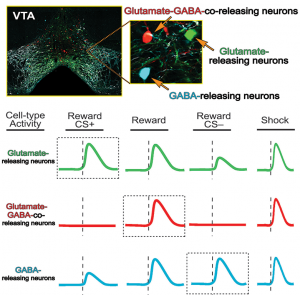 Hot Off the Press – November 23 , 2020
Hot Off the Press – November 23 , 2020
The Ventral tegmental area (VTA) is best known for containing dopamine neurons that play a role in motivated behavior. However, we had previously demonstrated that the VTA has neurons that co-transmit glutamate and GABA, neurons that transmit glutamate without GABA, and neurons that transmit GABA without glutamate. This discovery re-defined VTA neurons by multiple genetic characteristics rather than single genetic characteristics. In this paper, we report on the implementation of a novel methodological strategy to identify the circuits and functions for each of the aforementioned VTA cell-types. By combining recombinase mouse lines with newly developed INTRSECT vectors, we found that VTA cell-types have unique signaling patterns for reward, aversion, learned cues, and reward expectation. Whereas VTA glutamate-transmitting neurons signal cues predicting reward, VTA GABA-transmitting neurons signal cues predicting the absence of reward, and glutamate-GABA co-transmitting neurons signal rewarding and aversive outcomes without signaling learned cues related to those outcomes. Thus, we demonstrated that genetically-defined subclasses of VTA glutamate and GABA neurons signal different aspects of motivated behavior. Due to the novelty of the data presented in this paper, we anticipate that this paper will be a classical citation in basic and clinical research.
Publication Information
Distinct Signaling by Ventral Tegmental Area Glutamate, GABA, and Combinatorial Glutamate-GABA Neurons in Motivated Behavior Journal Article
In: Cell Reports, vol. 32, no. 9, 2020, ISBN: 2211-1247.
